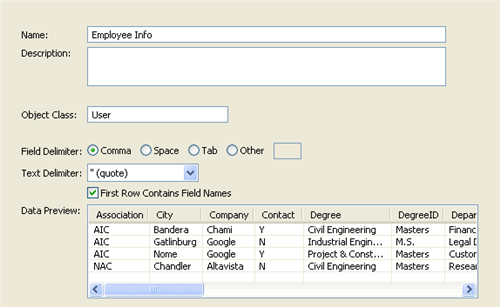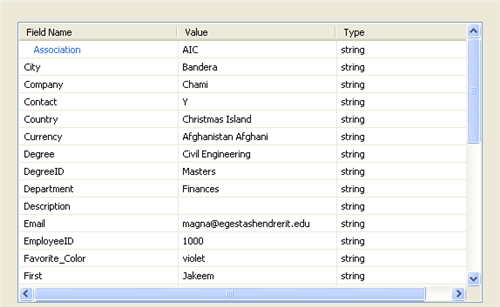3.3 Creating a Flat File Profile
If you need to access data that is in a flat file, such as a comma-delimited file or spreadsheet, create a flat file profile. Flat file profiles provide the details necessary for Analyzer to access the specified data file.
NOTE:If you need to get data from an application data store, see Section 3.2, Adding a Connection Profile.
-
In the Project view, expand the project with which you want to work.
-
Right-click , then select .
-
In the Import Delimited Text File dialog box, provide the following information, then click .
File Path: Specify the path to the desired file.
Encoding: Specify the character encoding used in the specified file. The default setting is UTF-8.
-
In the Delimited Text Settings dialog box, provide the following information about the selected file, then click .

Name: Specify a name for the flat file profile. This name is used for the profile object in the Project View. By default, this is the filename, but you can use any name you want.
Description: (Optional) Specifies a more detailed description for the flat file profile.
Object Class: Specify the object class to which the attribute values in the selected file should be associated. For example, a file of user information should be associated with the User class.
Field Delimiter: Specify the field delimiter used in the selected file. The default setting is a comma.
Text Delimiter: Specify the character used to enclose values that contain the field delimiter as part of the value. You can choose between double quotes (“ ”) and single quotes (‘ ’).
First Row Contains Field Names: When this option is selected, Analyzer treats the first row of the data file as field names. Analyzer treats these field names as attribute names, so they should match the appropriate attribute names in the associated Object Class.
-
(Conditional) In the Set Field Names dialog box, modify field names and data types as needed, then click .

Field Name: To adjust a field name for a particular column (attribute) in the flat file data table, double-click the current Field Name entry and make your changes.
Value: Displays a sample value for the associated flat file data column. Values are for information only and cannot be modified.
Type: To adjust the data type for a particular column (attribute) in the flat file data table, double-click the Type entry and select the appropriate data type from the drop-down list. Analyzer’s base schema provides the following Types:
Type
Description
string
Specifies that the attribute value is a character string.
teleNumber
Used by attributes whose values are telephone numbers. The length of telephone number strings must be between 1 and 32 characters. Two telephone numbers match when they are of the same length and their corresponding characters are identical, except that all spaces and hyphen characters are ignored during comparison.
int
Used by attributes represented as signed numeric values. Two Integer values match if they are identical. The comparison for ordering uses signed integer rules.
state
Used by attributes whose values are True (represented as 1) or False (represented as 0). The single-valued flag is set for this syntax type.
counter
Used by attributes whose values are incrementally modified numeric signed integers. Any attribute defined using Counter is a single-valued attribute. This syntax differs from Integer in that any value added to an attribute of this syntax is arithmetically added to the total, and any value deleted is arithmetically subtracted from the total.
dn
Used by attributes whose values are the names of objects in the eDirectory™ tree. Distinguished Names (DN) are not case sensitive, even if one of the naming attributes is case sensitive.
interval
Used by attributes whose values are signed numeric integers and represent intervals of time. The Interval syntax uses the same representation as the Integer syntax. The Interval value is the number of seconds in a time interval.
octet
Used by attributes whose values are strings of binary information not interpreted by eDirectory. These octet strings are non-Unicode* strings. For two octet strings to match, they must be the same length, and the corresponding bit sequence (octet) must be identical.
time
Used by attributes whose values are unsigned integers and represent time expressed in seconds.